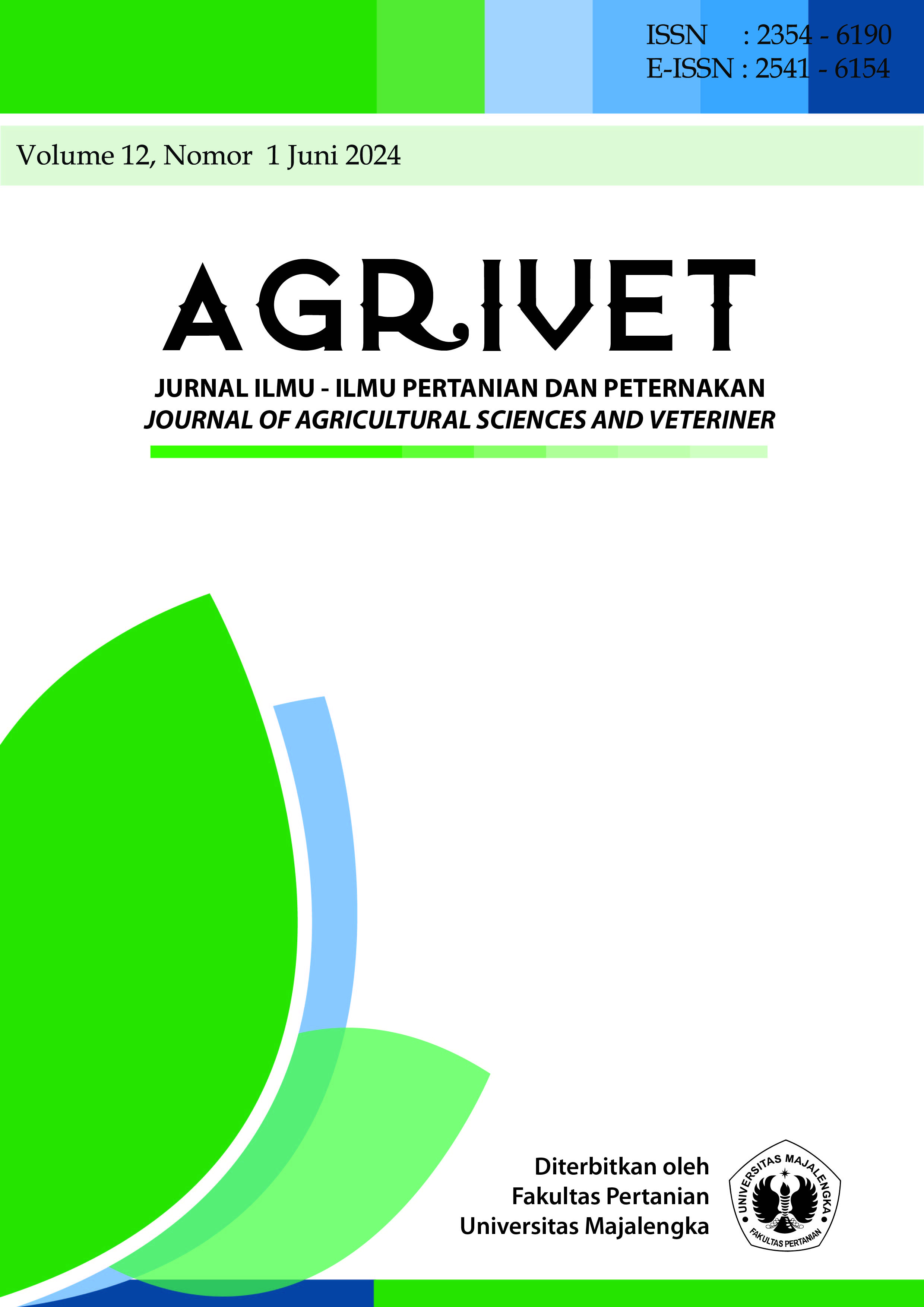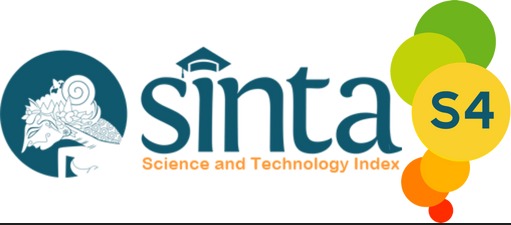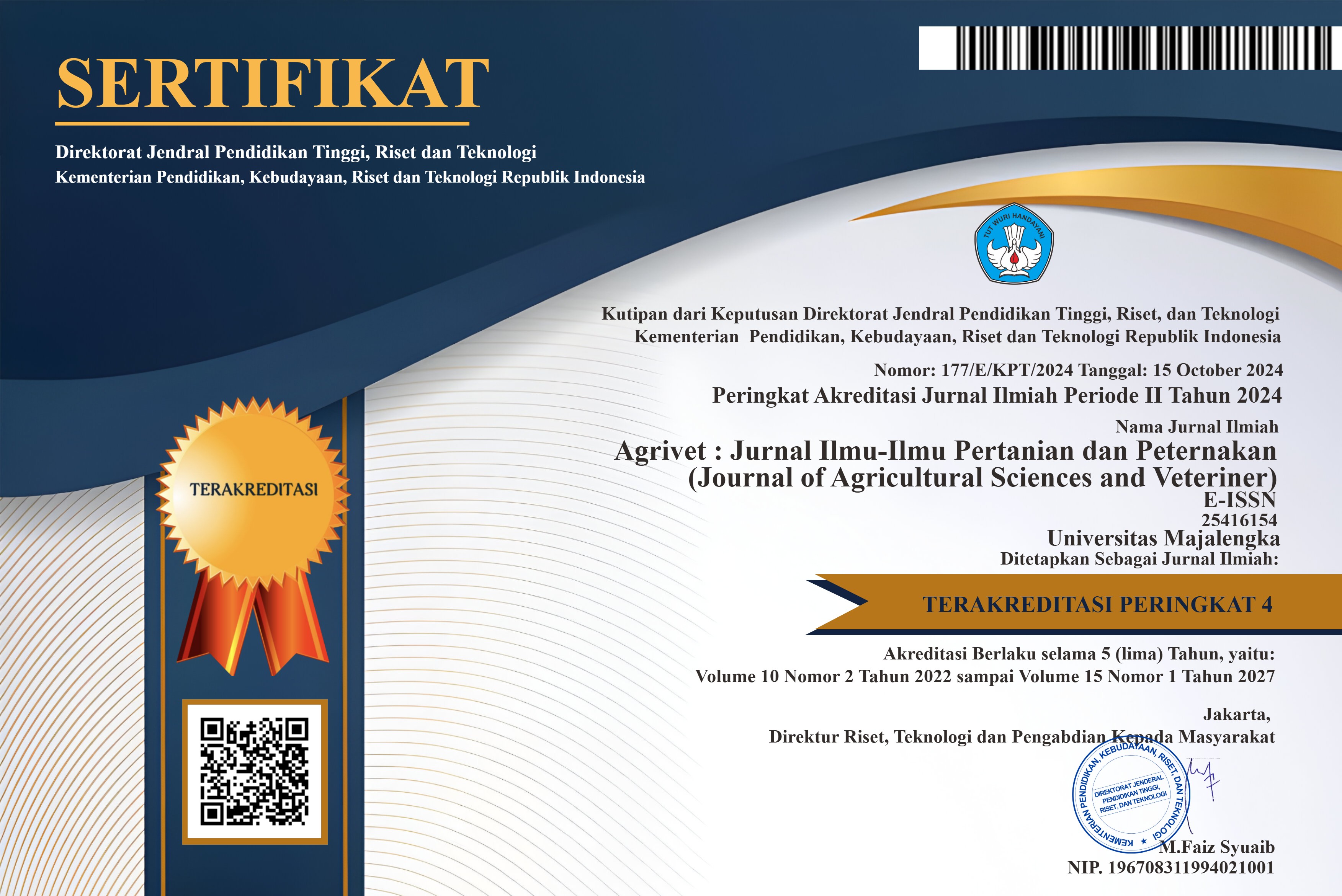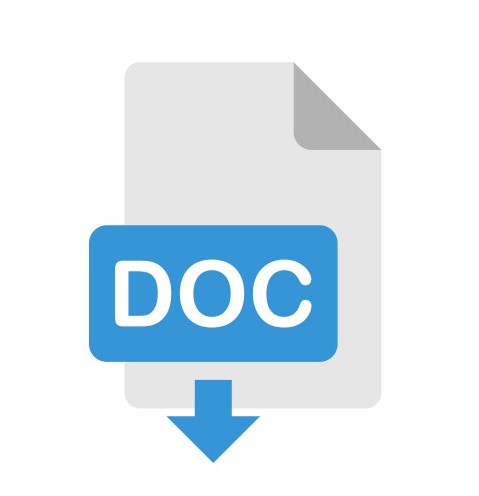Pengaruh perbedaan bentuk tempat pakan terhadap performa puyuh padjadjaran petelur fase brooding
DOI:
https://doi.org/10.31949/agrivet.v12i1.8756Abstract
This research purpose was to determine the effect of different feeder shape on performance of Padjadjaran Layer Quails in the brooding phase. This research was held in the Quail Breeding Center, Faculty of Animal Husbandry, Padjadjaran University used 360 male and female black line of Padjadjaran Layers Quail. There were 18 treatment cages, each cage unit containing 20 quails. This research used Completely Randomized Design (CRD) there were 3 treatments and repeated 6 times. The treatment given to quail from 1 until 3 weeks of age consisted of trough feeder (P1), baby chick feeder (P2) and feeder tray (P3). Data of feed consumption, body weight gain, and feed convertion ratio were analyzed using variance and Duncan’s Multiple Range Test. Total feed consumption is as follow 240,59 gram, 257,38 gram, and 247,55 gram. Each successive body weight gais is as follow 84,20 gram, 109,57 gram, and 98,47 gram. Average of feed convertion ratio is as follow 2,87; 2,39; and 2,52. The conclusion from result showed that the different feeder shape affected on performance of Padjadjaran Layer Quails in the brooding phase. Baby chick feeder provides good performance for laying Padjadjaran quail in the brooding phase.
Keywords:
Padjadjaran quail, Feeder shape, Performance, Brooding phaseDownloads
References
Achmanu., Muharlien., Salaby. 2011. Pengaruh Lantai Kandang (Rapat dan Renggang) dan Imbangan Jantan-Betina Terhadap Konsumsi Pakan, Bobot Telur, Konversi Pakan dan Tebal Kerabang pada Burung Puyuh. Jurnal Ternak Tropika. 12(2): 1–14.
Agustina, D., N. Iriyanti., and S. Mugiyono. 2013. Pertumbuhan Dan Konsumsi Pakan Pada Berbagai Jenis Itik Lokal Betina Yang Pakannya Di Suplementasi Probiotik. Jurnal Ilmiah Peternakan. 1(2): 691–98.
Anang, A., H. Indrijani, and E. Sujana. 2017. Mathematical Model of Growth of Two Purelines of Padjadjaran Female Quail Aged 0 to 6 Weeks. Journal of the Indonesian Tropical Animal Agriculture. 42(2): 66–71.
Armen., Ristiono., and E. Novriyanti. 2013. Pengaruh Jumlah Pintu Makan Terhadap Produksi Telur Burung Puyuh. Jurnal Sainstek. 5(2): 123–27.
Dewi, R.R., E.Sujana., and A. Anang. 2016. Performa Pertumbuhan Puyuh (Coturnix-Coturnix Japonica) Petelur Jantan Hasil Persilangan Warna Bulu Hitam Dan Coklat Umur 0-7 Minggu Di Pusat Pembibitan Puyuh. Media Peternakan. 5(4): 1–9.
Djulardi, A. 2022. Nutrisi Puyuh Konsep Dan Apliksinya. Minangkabau Press, Padang.
Iwan., H.M., and R.A. 2018. Pengaruh Media Pakan Baki (CFT) dan Baby Chick Feeder (BCF) terhadap Konsumsi Pakan, Pertambahan Berat Badan Harian dan Konversi Pakan pada Ayam Ras Pedaging. Jurnal Wahana Peternakan. 2(2):1-7.
Lase, H. Geofrin., E. Sujana, and H. Indrijani. 2016. Petelur Betina Silangan Warna Bulu Coklat Dan Hitam Di Pusat Pembibitan Puyuh Universitas Padjajaran. Jurnal Peternakan Universitas Padjajaran. 2(1): 1–7.
Lokapirnasari, W. P. 2017. Nutrisi Dan Manajemen Pakan Burung Puyuh. Airlangga University Press, Surabaya.
Mohammed, H.H., I.F. Rehan., A.F. Abou-Elnaga, and R.A. Mohamed. 2019. Effects of Feeder Shape on Behavioral Patterns, Performance and Egg Quality Traits of Japanese Quail.” Slovenian Veterinary Research. 56(22): 139–48.
Nurcholis, N., D.Hastuti., and B. Sutiono. 2009. Tatalaksana Pemeliharaan Ayam Ras Petelur Periode Layer Di Populer Farm Desa Kuncen Kecamatan Mijen Kota Semarang. Mediagro. 5(2): 38–49.
Perkasa, B.G., and E. Sudjarwo. 2019. Pemanfaatan Tepung Limbah Kepala Udang Dalam Ransum Burung Puyuh Terhadap Performan, Konversi, Dan Umur Pertama Bertelur. Jurnal Nutrisi Ternak Tropis. 2(2): 51–58.
Prasetyo, A.K. 2020. Pengaruh Penggunaan Berbagai Model Tempat Pakan terhadap Performan Ayam Petelur Selama Masa Brooding. Prosiding Seminar Nasional Kahuripan. 121-125.
Prayitno., D.S., Sugiharto. 2021. Kesejahteraan dan Metode Penelitian Tingkah Laku Unggas. Badan Penerbit Universitas Diponegoro, Semarang.
Radhitya, A. 2015. Pengaruh pemberian tingkat protein ransum pada fase grower terhadap pertumbuhan puyuh (Coturnix coturnix japonica). Students e-Journal. 4(1).
Rohayeti, Yeti, Dela Heraini, and Gregoriana Tri Bulauati. 2023. “Tepung Umbi Bawang Dayak (Eleutherine Palmifolia (L) Merr) Sebagai Feed Additive Burung Puyuh (Coturnix-Coturnix Japonica). Jurnal Ilmu dan Industri Peternakan. 9(1): 54–61.
Subekti, E., and D.Hastuti. 2013. Budidaya Puyuh (Coturnix Coturnic Japonica) Di Pekarangan Sebagai Sumber Protein Hewani Dan Penambah Income Keluarga. Mediagro. 9(1): 1–10.
Sudjarwo, E., A. A. Hamiyanti., H. S. Prayogi., dan D. L. Yulianti. 2019. Manajemen Produksi Ternak Unggas. Universitas Brawijaya Press, Malang.
Sujana, E. 2020. Kajian Performa Puyuh Malon, Puyuh Jepang Terseleksi dan Persilangannnya Dalam Membentuk Bibit Puyuh Pedaging Unggul. Disertasi. Universitas Padjadjaran.
Tamalludin, F. 2012. Ayam Broiler, 22 hari Panen Untung. Penebar Swadaya. Jakarta.
Wijaya, D., I. Setiawan., E. Sujana. 2021. Identifikasi Sifat Kualitatif Dan Kuantitatif Puyuh Betina Persilangan Malon Dengan Coturnix-Coturnix Japonica Di Laquila Farm Sukabumi. Jurnal Produksi Ternak Terapan. 2(2):46-53.
Wuryadi, S. 2013. Beternak Puyuh. AgroMedia Pustaka, Jakarta.
Zhang, X., X. Wang., W. Wang., R. Xu., C.Li., F.Zhang. 2021. Effects of Personality Traits on the Food-Scratching Behaviour and Food Intake of Japanese Quail (Coturnix japonica). Animals. 11(12):3423.
Published
How to Cite
Issue
Section
License
Copyright (c) 2024 Fanya Nur Haryani, Endang Sujana, Iwan Setiawan

This work is licensed under a Creative Commons Attribution-ShareAlike 4.0 International License.
An author who publishes in the Jurnal Agrivet agrees to the following terms:
- Author retains the copyright and grants the journal the right of first publication of the work simultaneously licensed under the Creative Commons Attribution-ShareAlike 4.0 License that allows others to share the work with an acknowledgment of the work's authorship and initial publication in this journal
- The author is able to enter into separate, additional contractual arrangements for the non-exclusive distribution of the journal's published version of the work (e.g., post it to an institutional repository or publish it in a book) with the acknowledgment of its initial publication in this journal.
- The author is permitted and encouraged to post his/her work online (e.g., in institutional repositories or on their website) prior to and during the submission process, as it can lead to productive exchanges, as well as earlier and greater citation of the published work












